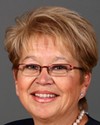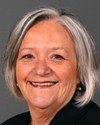Good afternoon, everyone.
I've journeyed since Friday, because I stopped here and there. It's a long journey to get here, but I'm very happy to be here.
This year our council is just finishing up the Northern Women in Mining, Oil and Gas project. Along with our other duties, we have done a special project around non-traditional trades for women who are under-represented in the workforce.
I'll just start by giving a brief description of the project.
The Status of Women Council and their project partners introduced Northern Women in Mining, Oil and Gas, a project that attempted to answer the following research question. Given the current population of unemployed and underemployed women in the Northwest Territories, will a dedicated women-only, partnership-based, and strategic approach to training and development be successful in increasing the interest levels and participation and retention rates of women in industrial and trades-based occupations in the northern mining, oil, and gas industries?
Having almost concluded the project, we realize our research question was too long. Were we to do another project, we would actually probably shorten up that research question a little bit.
The anticipated barriers, or social challenges, for women to enter the trades-based occupations were lack of appropriate education and skills, often; sometimes the only primary caregiver; limited training opportunities; financial restrictions; perception and traditional perspective that trades occupations are not for women; and social issues around abuse and addictions. The top three barriers identified by applicants, and consistent with proposal research, were the lack of the right skills and education, financial concerns, and an image that it's a man's working environment.
In the project, we did three different types of courses. We did exposure courses, which were five-week courses offered mainly in the evening around carpentry. We did do two community-based projects. One was in Trout Lake, which is a community of 90 people, and we did an HEO, heavy equipment operation, course there. We also did a summer airport maintenance course in Hay River, which is a bigger community in the north, with perhaps 1,000 to 1,500 people. Both of those were very successful. The women who took the training are looking for additional training. Some are working, some are faced with daycare issues, but they actually passed the course while we were there.
We did a trades access program, which was an academic program that challenged women to enter the trades entrance exam. What they did is mostly an upgrading kind of education to help them pass the trades entrance exam. The intention was for the women to write the trades entrance exam and move into apprenticeship programs, and attain employment in the trades. Prior to the conception of the project, we had made some connections with the mining companies and they had intended on hiring women once they passed. They did hire three of the women, but with the downturn of the global economy, we're still waiting for them to hire more.
We also did a building trades helper program, which was a 12-week program. It was combined hands-on training with basic academics, and a Ready to Work North program. It prepared women for entry-level positions in the trades industry. We did have a lot of success around those kinds of courses, and the mines were very happy to hire them.
The biggest issue with the mining in the Northwest Territories is because of the two weeks in, two weeks out, so if mothers are single parents, it's often very challenging for them to find a place for their youngsters.
In the project we did a wraparound service, so women in the project were offered all different kinds of wraparound services such as upgrading, so if they were having trouble at school, they could go to a tutor after hours. We did referrals to get them into housing, and we tried to get them child care, all those kinds of things. In the north they have a student FSA program, which is like a student loan program where, if people work in the north, their loans are forgiven.
So they all got those. Personal counselling, housing advocacy, transportation...the women were given the funds to travel from the communities, which in the Northwest Territories can be very expensive. We gave them work clothing, phone cards, grocery gift cards, and anything to help them be successful in their programs.
In year one we had 37 applications; in year two, 43 applications; and in year three, 73 applications. Now that we're waiting for funding we have women on waiting lists trying to get into the program. After three years our program is beginning to be known in the north, so women are interested, but we're waiting for new funding.
On the challenges for our program, academic entry requirements for parts of the training made it difficult to recruit qualified candidates, so a lot of the women who applied did not qualify for the upgrading at Aurora College, which is a community college in the north.
The retention of women beyond the training into trade-specific apprenticeship programs was not always successful. Often that was due to child care or addictions issues. Participants in the programs did not seem interested in pursuing careers in the trades, despite the barriers being addressed. So probably the next thing we will research is why they entered. There are different ideas about why women do that. If they are in certain programs it might be a way for them to qualify for other programs. We're not quite sure why they would enter if they weren't interested.
The mining industry requires skilled professions and educational requirements. Traditional values and child care responsibilities pose significant challenges in filling these positions. A lot of that is due to the two weeks in, two weeks out. Of course the economic recession did not allow for new staff hires.
On the successes, 23 women successfully completed the Building Trades Helper and Trades Access programs. Women have written their trades entrance exams. Five women have attained employment post training and are still working. We have found with the program that although they may not have gone into trades-related programs, they are now working. They might be working at a library; it might not be with a shovel, but they are working. So in terms of that we've had huge successes.
Am I out of time?











